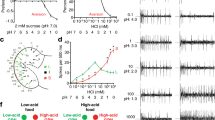Summary
The water receptor in the “large” labellar taste hairs ofProtophormia terraenovae was investigated with electrophysiological methods. Total inhibition of the water receptor activity, achieved by sodium citrate, can be undone by certain sugars to different degrees. The inhibition by salt as well as the “reactivation” by D-fructose occur with Hill-coefficients greater 2, indicating strong positive cooperativity of the receptor membrane. The water receptor reacts highly specific: Of 16 sugars tested only D-fructose, D-fucose, and D-galactose are potent “reactivators”, while other monosaccharides as well as oligosaccharides and glucosides are less or not effective.
Similar content being viewed by others
References
Changeux, J.P., Thiéry, J.: On the excitability and cooperativity of biological membranes. In: Regulatory functions of biological membranes (ed. J. Järnefelt). BBA Library (Amsterdam)11, 116–138 (1968)
Dethier, V.G.: The physiology of insect senses. London: Methuen 1963
Dethier, V.G.: The hungry fly. Cambridge, Massachusetts: Harvard University Press 1976
Dethier, V.G., Goldrich-Rachman, N.: Anesthetic stimulation of insect water receptors. Proc. nat. Acad. Sci. (Wash.)73, 3315–3319 (1976)
Evans, D.R., Mellon, D.: Electrophysiological studies of a water receptor associated with the taste sensilla of the blowfly. J. gen. Physiol.45, 487–500 (1962)
Gothilf, S., Galun, R., Bar-Zeev, M.: Taste reception in the Mediterranean fruit fly: Electrophysiological and behavioural studies. J. Insect Physiol.17, 1371–1384 (1971)
Hodgson, E.S., Roeder, K.D.: Electrophysiological studies of arthropod chemoreception. I. General properties of the labellar chemoreceptor of diptera. J. cell. comp. Physiol.48, 51–76 (1956)
Ma, Wei-Chun: Dynamics of feeding responses inPieris brassicae L. as a function of chemosensory input: a behavioural, ultra-structural and electrophysiological study. Meded. Landbouwhogesch. Wageningen72, 1–162 (1972)
Morita, H.: Electrical signs of taste receptor activity. In: III. Internat. Symp. Olfaction and Taste, New York 1968 (ed. C. Pfaffmann), pp. 370–381. New York: Rockefeller University Press 1969
Morita, H., Shiraishi, A.: Stimulation of the labellar sugar receptor of the fleshfly by mono and disaccharides. J. gen. Physiol.52, 559–583 (1968)
Morita, H., Yamashita, S.: Generator potential of insect chemoreceptor. Science130, 922 (1959)
Ninomiya, M., Shimada, I.: Stereospecificity for oligosaccharides of two receptor sites in a labellar sugar receptor of the fleshfly. J. Insect Physiol.22, 483–487 (1976)
Rees, C.J.C.: The primary process of reception in the type 3 (“water”) receptor cell of the fly,Phormia terraenovae. Proc. roy. Soc. B174, 469–490 (1970)
Rees, C.J.C.: Responses of some sensory cells probably associated with the detection of water. In: IV. Intern. Symp. Olfaction and Taste, Starnberg 1971 (ed. D. Schneider), pp. 88–94. Stuttgart: Wiss. Verlagsges. 1972
Shimada, I.: The stimulating effect of fatty acids and amino acid derivatives on the labellar sugar receptor of the fleshfly. J. gen. Physiol.71, 19–36 (1978)
Shimada, I., Shiraishi, A., Kijima, H., Morita, H.: Effects of sulphhydryl reagents on the labellar sugar receptor of the fleshfly. J. Insect Physiol.18, 1845–1855 (1972)
Shimada, I., Shiraishi, A., Kijima, H., Morita, H.: Separation of two receptor sites in a single labellar sugar receptor of the flesh-fly by treatment with p-chloromercuribenzoate. J. Insect Physiol.20, 605–621 (1974)
Shiraishi, A., Kuwabara, M.: The effects of amino acids on the labellar hair chemosensory cells of the fly. J. gen. Physiol.56, 768–782 (1970)
Starre, H., van der: Tarsal taste discrimination in the blowfly,Calliphora vicina Robineau-Desvoidy. Neth. J. Zool.22, 227–282 (1972)
Wieczorek, H.: The glycoside receptor of the larvae ofMamestra brassicae L. (Lepidoptera, Noctuidae). J. comp. Physiol.106, 153–176 (1976)
Wieczorek, H., Köppl, R.: Elektrophysiologischer Nachweis eines zweiten Zuckerrezeptors in den labellaren Schmeckhaaren der Fliege. Verh. Dtsch. Zool. Ges., p. 331. Stuttgart: Gustav Fischer Verlag 1977
Wilczek, M.: The distribution and neuroanatomy of the labellar sense organs of the blowflyPhormia regina Meigen. J. Morph.122, 175–201 (1967)
Author information
Authors and Affiliations
Additional information
We thank Prof. Dr. K. Hansen for valuable discussions and for critical reading of the manuscript. We are also greatly indebted to Miss S. Dietz and Mrs. H.Kübler for technical assistance. The work was supported by grants from the Deutsche Forschungsgemeinschaft (Schwerpunktprogramm Rezeptorphysiologie).
Rights and permissions
About this article
Cite this article
Wieczorek, H., Köppl, R. Effect of sugars on the labellar water receptor of the fly. J. Comp. Physiol. 126, 131–136 (1978). https://doi.org/10.1007/BF00666365
Accepted:
Issue Date:
DOI: https://doi.org/10.1007/BF00666365




